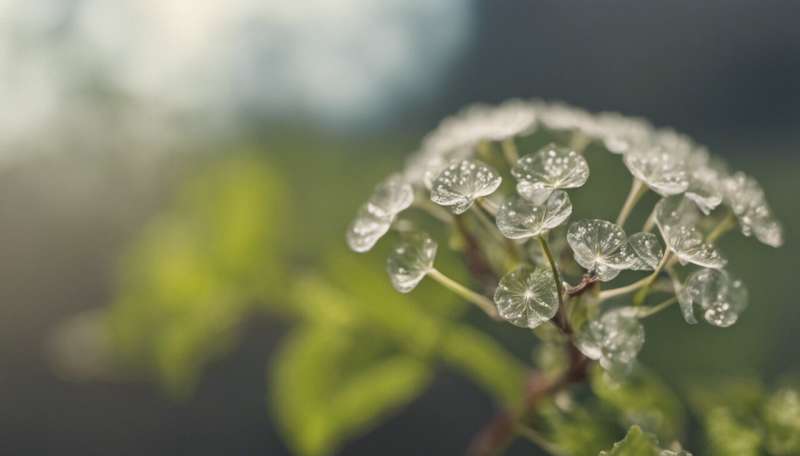This article has been reviewed according to Science X's editorial process and policies. Editors have highlighted the following attributes while ensuring the content's credibility:
fact-checked
trusted source
written by researcher(s)
proofread
Ivy, dandelions and other common wildflowers are a crucial resource for pollinating insects

Since the end of the second world war, factors such as more intensive farming and urbanization have reduced the abundance of wildflowers in Britain. In fact, the past 90 years have seen the loss of over 97% of the UK's wildflower meadows.
Simply planting more wildflowers seems an obvious solution—although difficult on a large scale. There's just one problem. Many common British wildflowers are undervalued and even disliked by the public, who consider them to be weeds.
These flowers, which include many species from dandelion and clover to bramble and ivy, provide large amounts of pollen and nectar for bees and other insects. But some people consider dandelions a nuisance in their gardens. Others dislike brambles because of their thorns and vigorous growth. And even plants like ivy, with inconspicuous flowers, are wrongly thought to be unhelpful to bees.
Greater appreciation of wildflowers like these will not only help to improve the food supply for bees and other flower-visiting insects, it will also help reconnect people with plant diversity and nature. So, what will it take for people to accept and enjoy more wildflowers in their lawns, parks, roadsides and fields?
One clear answer is education. In Britain, knowledge about plants seems to be lacking. A phenomenon called "plant blindness"—an inability to notice or appreciate plants, distinguish between species or recognize their importance—could be one reason for negative public attitudes towards native plants.
In 2005, a study of UK A-level students found that 86% could name only three or fewer common wildflowers. And in 2017, only 3.5% of British participants in a poll commissioned by UK conservation charity Plantlife were able to name a red clover correctly. These figures show the disconnect between people and plants.
This is surely not a good thing. Bees and other flower-visiting insects rely heavily on flowers, and most life on Earth depends either directly or indirectly on plants. Although underappreciated, common native wildflowers are an important part of this.
Sources of pollen
Ivy is a common climbing plant that grows on walls, tree trunks and in hedges throughout Britain's towns and countryside. Ivy is often falsely accused of strangling the trees it climbs or parasitizing them by embedding its roots into the tree itself.
But the reality is far less sinister. During the autumn, ivy blooms and becomes the main source of nectar and pollen for a wide range of insects, including honey bees, ivy bees, bumble bees, hover flies, butterflies and wasps. In fact, pollen analysis from work published in 2021 on honey bee hives in Sussex suggests that 90% of the pollen that is collected in autumn comes from ivy.
The nectar and pollen provided by ivy's open flowers are also accessible to all insects. Even insects with shorter tongues can gather ivy nectar. In contrast, plants like lavender secrete nectar at the base of the flower tube and thereby restrict access to insects with longer tongues such as bumble bees and butterflies.
Bramble, also called blackberry, parallels ivy. It is abundant in both urban and rural settings and its open flowers are accessible to all types of insect.
Bramble blooms for a long period of time, starting in late May and continuing into autumn. In one study, when we used pollen traps (an apparatus that dislodges some of the pollen pellets from honey bee legs as they return to the hive), we found that 31% of the pollen collected from late May to early August comes from bramble.
What about weeds?
Dandelions and white clover are native wildflower species that also provide pollen and nectar. Both are often found in lawns but are not always appreciated. Garden centers even sell herbicides to eliminate these and other "weeds" from lawns.
Interestingly, five native wildflower species in Britain are officially classified as "injurious weeds", and having them on your land is technically illegal. Among these are ragwort and two species of both dock and thistle. These plants are found almost anywhere, from road verges to fields, waste land and even gardens.
However, our more recent research, which was carried out in Sussex, revealed that these so-called injurious weeds attract twice as many flower-visiting insects as wildflower species that are officially recommended as "good for pollinators".
Appreciating native plants
To truly encourage appreciation and support for native wildflowers, we need to shift people's perspective. Instead of viewing lawns with wildflowers as unattractive or a sign of laziness, let's celebrate the benefits they bring. It's certainly easier, cheaper and probably safer to enjoy existing wildflowers than to go to the trouble of removing them with herbicides.
Many of these underappreciated wildflowers are already popular beyond their value as nectar and pollen sources. Blackberries, for example, are widely eaten as a wild food in Britain, while the name Ivy holds a special place for some.
We must recognize that local native wildflower species with pollinator-friendly flowers already exist almost everywhere. By appreciating and supporting them, we not only assist pollinators, but also gain psychological benefits by reconnecting with the wonders of plants and nature.
Provided by The Conversation
This article is republished from The Conversation under a Creative Commons license. Read the original article.![]()


















